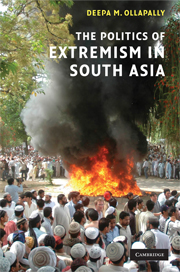Book contents
- Frontmatter
- Contents
- Acknowledgements
- Map of South Asia
- 1 Introduction: beyond and before the 9/11 framework
- 2 Situating violent conflict in South Asia
- 3 Afghanistan's changing fortunes
- 4 Pakistan at the crossroads
- 5 Conflict and contradiction in Kashmir
- 6 Sri Lanka's violent spiral
- 7 Bangladesh: divided politics and geopolitics
- 8 Conclusion
- Bibliography
- Index
1 - Introduction: beyond and before the 9/11 framework
Published online by Cambridge University Press: 05 September 2012
- Frontmatter
- Contents
- Acknowledgements
- Map of South Asia
- 1 Introduction: beyond and before the 9/11 framework
- 2 Situating violent conflict in South Asia
- 3 Afghanistan's changing fortunes
- 4 Pakistan at the crossroads
- 5 Conflict and contradiction in Kashmir
- 6 Sri Lanka's violent spiral
- 7 Bangladesh: divided politics and geopolitics
- 8 Conclusion
- Bibliography
- Index
Summary
Re-examining extremism
In the popular mind, extremism and terrorism are invariably linked to ethnic and religious factors. Yet the dominant history of South Asia is notable for tolerance and co-existence, despite highly plural societies. What then accounts for the rise of extremist ethno-religious groups in societies that were historically not predisposed thus? What determines the winners and losers in the identity struggles that we see in South Asia, and what tips the balance between more moderate and extremist outcomes? Despite the unprecedented international attention South Asia has received in the wake of the terrorist attacks on September 11, 2001, we would be hard-pressed to conclude that our understanding of extremism and our capacity to combat it, have improved significantly. If anything, the situation has become more dire – from Afghanistan to Pakistan to Sri Lanka to Bangladesh, extremist violence is breaking out anew or remains unabated. Much of the post-9/11 analysis is from a US policy perspective with little theoretical or historical content, and for a region that has an overabundance of history and political complexity, such an approach is far too limited.
We need a new way to grasp the complex of political and geopolitical factors that have determined outcomes in South Asia over the contemporary period, pre- and post-9/11. It would seem vitally important to re-examine a phenomenon that shows little signs of receding, let alone being defeated.
- Type
- Chapter
- Information
- The Politics of Extremism in South Asia , pp. 1 - 21Publisher: Cambridge University PressPrint publication year: 2008



